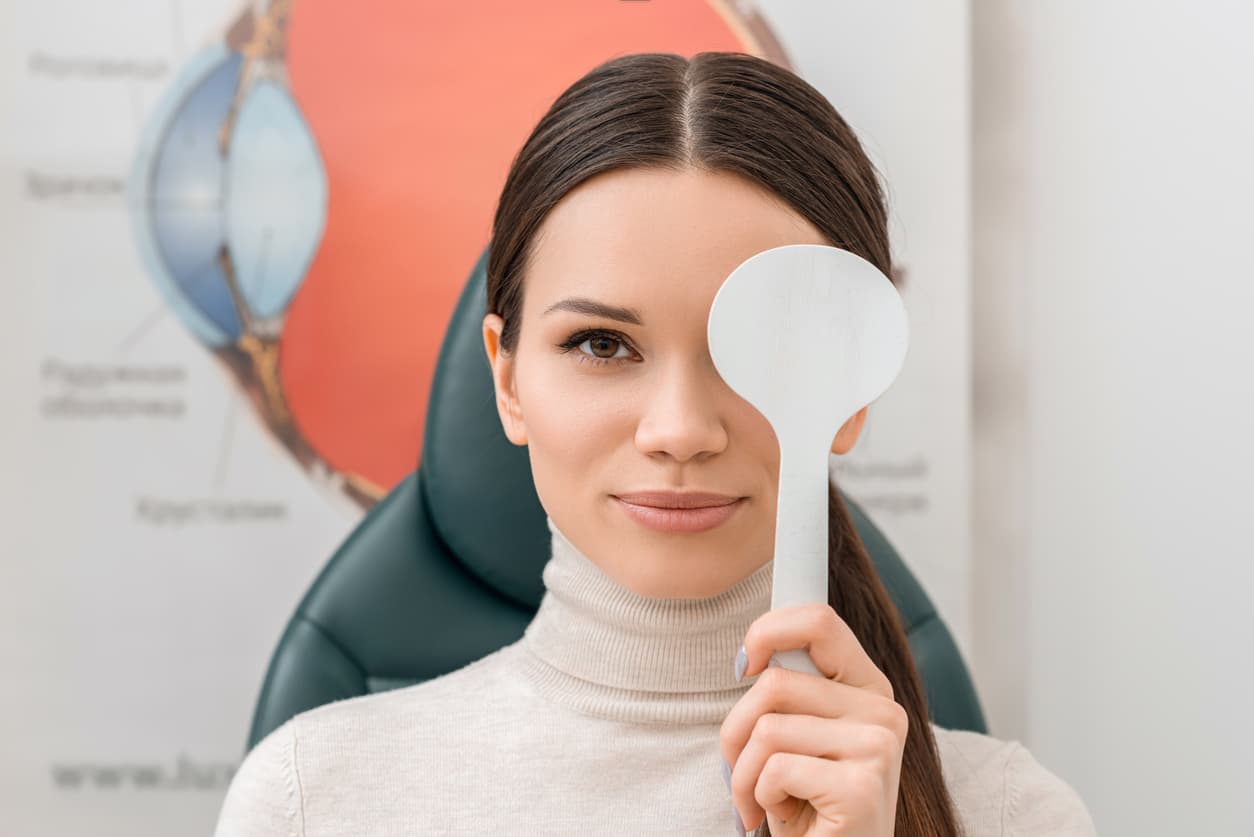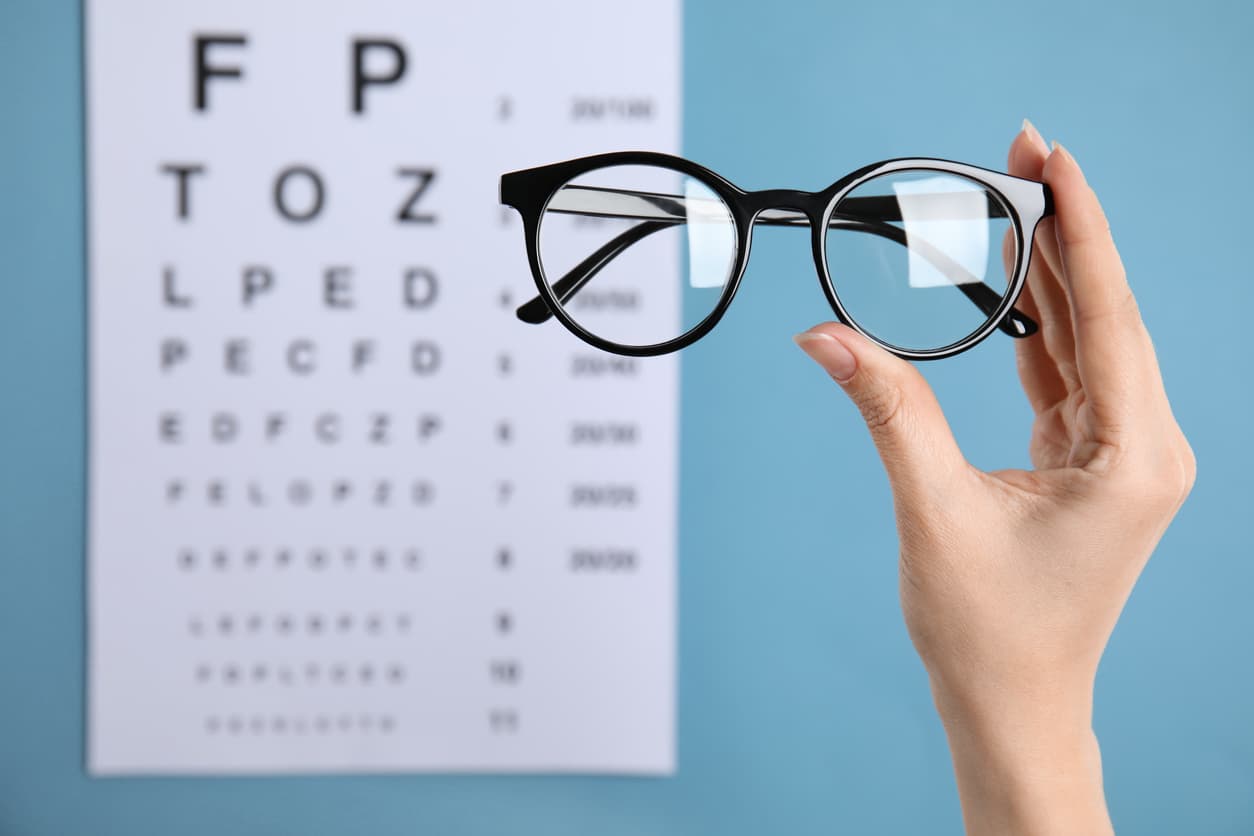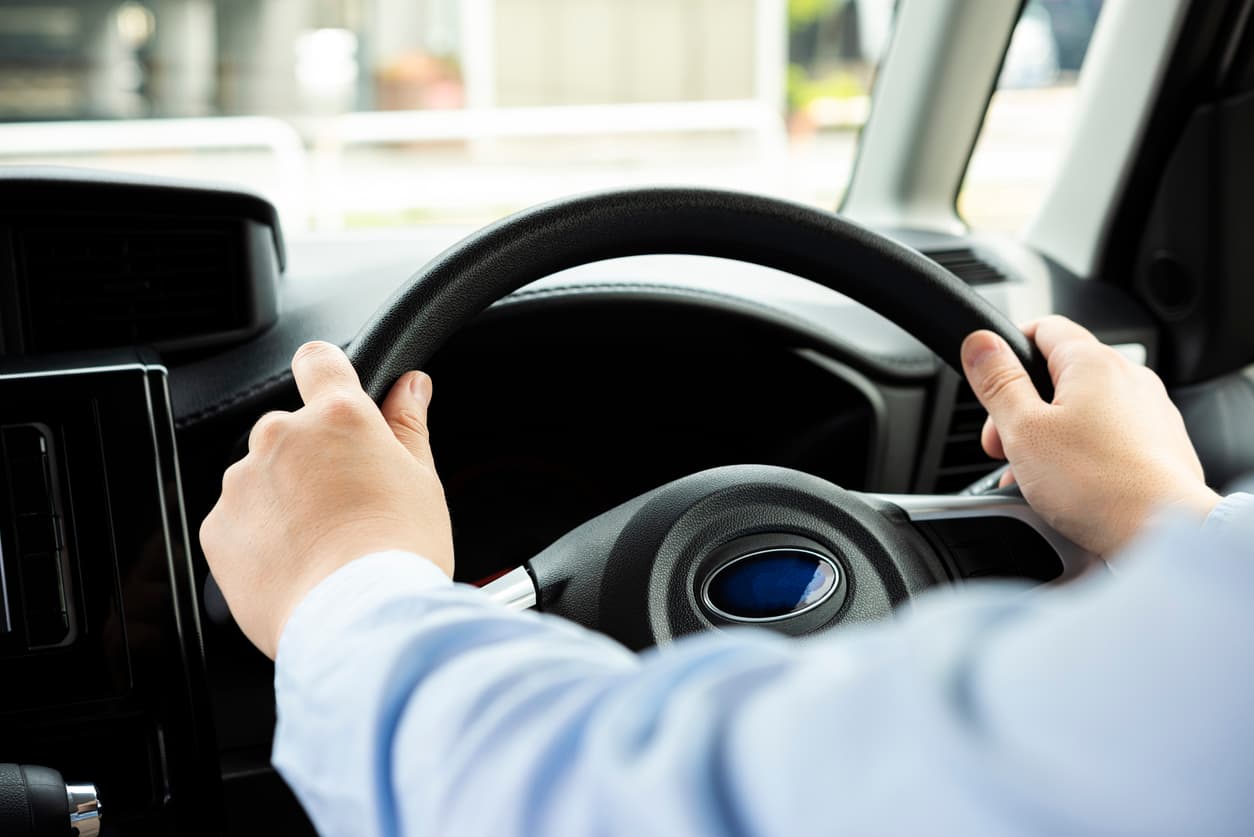運転免許はどれだけ学科や技能に問題がなくとも、視力検査で一定の基準を満たさないと取得も更新も認められません。一定の視力は、運転中に歩行者の存在や標識、信号、車間などを判断して安全確保するため、すべてのドライバーに求められます。
本記事では、視力に自信がなく取得や更新が不安な人向けに、運転免許の種類ごとの基準や検査方法、落ちたときの対策を紹介します。スムーズに検査をクリアできるよう、ぜひ参考にしてみてください。
目次
運転免許を取得するために必要な視力の基準

視力の基準は取得する運転免許の種類によって3つに分かれています。そのため、たとえば原付免許の取得では検査に合格できたのに、普通車では引っかかるといったケースがありえます。3つの区分と基準を紹介します。
普通第一種免許の場合
普通自動車や軽自動車を運転できる普通第一種免許の場合、視力検査の基準は次のどちらかの合格が必要です。
- 両眼で0.7以上かつ片眼でもそれぞれで0.3以上
- 片眼が0.3未満や見えなくても、他方で視力が0.7以上かつ左右の視野が150度以上
同じ視力の条件で取得や更新をできる免許は次のものです。
- 普通仮免許:初めて運転免許を取得する人が路上教習のために必要な免許
- 準中型第一種(5t限定準中型):2007~2017年に普通第一種免許を取得した人向けの免許
- 中型第一種免許(8t限定中型):2007年6月1日以前に普通第一種免許を取得した人向けの免許
- 大型特殊免許:クレーン車やブルドーザーなどを運転するための免許
- 普通二輪免許:排気量50cc超400cc以下の自動二輪を運転するための免許
- 大型二輪免許:排気量400cc超の自動二輪を運転するための免許
原付・小型特殊免許の場合
原付免許や、フォークリフトや農機のトラクターを運転できる小型特殊免許の場合、基準は次の通りです。
- 両眼で0.5以上
- 片眼が見えない人は、他方で視力が0.5以上かつ視野が150度以上
普通第一免許より求められる基準は低く、片眼ずつでの視力も検査はありません。
大型第一種免許の場合
大型第一種免許は、車両総重量11t以上、最大積載量6.5t以上のトラックやダンプカーまで運転できるようになる免許です。求められる視力の基準は、次の通りです。
- 両眼で0.8以上かつ片眼でもそれぞれで0.5以上
- 深視力の検査で誤差が2cm以下
上記の2種類と違い、片眼が見えない人は取得も更新もできません。同様の条件で取得や更新ができるのは、大型第一種免許以外に次のものがあります。
- 準中型・中型・大型の仮免許:それぞれで路上教習を受けるための免許
- 準中型第一種免許(限定なし):車両総重量3.5t以上7.5t未満、最大積載量2t以上4.5t未満、乗車定員10人以下のものを運転できる免許
- 中型第一種免許(限定なし):車両総重量7.5t以上11t未満、最大積載量4.5t以上6.5t未満、乗車定員11人以上29人以下のものを運転できる免許
- けん引免許:車両総重量が0.75t越えの自動車をけん引するのに必要な免許
- 第二種免許:タクシーやバスのようにお客を乗せて運転するための免許
運転免許を取得・更新するときの視力検査の種類と方法

運転免許の基準で使われる視力や視野角、深視力はどのように検査するのでしょうか。視力だけならば、これまで学校や職場の健康診断などで受けたことはあると思います。改めて検査の仕組みから見ていきましょう。
更新・取得時はランドルト環検査
ランドルト環検査とは、アルファベットのCのようなマーク(ランドルト環)を用いて、切れ目を認識できるかを調べる世界で一般的な方法です。視力が1.0とは、次の式で求められます。
視力1.0=1÷視角が1分
- 視角:見るものの両端と目までの直線が作る角度
- 1分(ぶ):角度の単位で1度の60分の1
5m離れて、高さ7.5mmマークの太さ1.5mm、切れ目の幅1.5mm認識できると、視力は1.0となります。両眼で見るか片側を隠して、大きなランドルト環からどちらの向きに切れ目があるのかを答えていきます。病院での視力検査ではひらがなやカタカナが使われるケースはありますが、運転免許の場合はランドルト環がメインです。
免許センターでの実際の視力検査では、切れ目の向きにすべて正答していると数回答えるだけで終わります。運転免許の条件に合格できているか判断するための検査で、見える上限を調べるものではなく検査時間も短時間です。
片目の場合は視野角の検査
視野角の検査は、普通第一種免許や原付・小型特殊免許の取得や更新で、ランドルト環検査の基準に合格できなかったときに行われます。頭を固定して片眼を隠し、光指標がどこまでの範囲で見えるのかを測ります。専用の機器に顎を載せ、ランダムに光るので見えたところで応答のボタンをおしましょう。
中心からどこまで見えるかを測るため、検査中は正面を向いたままで眼を動かしてはいけません。片眼の検査で5〜15分程度かかります。免許センターによっては、光指標を使わず、頭を固定したあとに視界の左右からものが近づき、見えたところで返事をするといったケースもあります。
免許の種類によっては深視力検査
深視力検査は、動いている物体の遠近感や立体感をどれだけ認識できているかを調べます。普通自動車より大型のものに乗ることになる、次の運転免許の取得や更新で、基準に含まれています。
- 準中型・中型・大型の仮免許
- 準中型第一種免許(限定なし)
- 中型第一種免許(限定なし)
- 大型第一種免許
- けん引免許
- 第二種免許
検査方法は三稈法(さんかくほう)と呼ばれ、次の6ステップで行われます。
- 指定の位置で検査機を覗く
- 3本の棒が横一列に並んでいるのを確認
- 真ん中の棒が奥から手前に動かされる
- 3本の棒が1列になったと思うところで合図
- 動いていた棒が残りの棒と前後でどれだけズレているかを測定
- 3から4を合計3回行う
3回の測定で、ズレの平均が2cm以内で合格です。
視力検査の合格に必要な条件

視力検査は裸眼もしくはコンタクトレンズやメガネで矯正した状態でも受けられます。運転時のみメガネをかけるという方は、当日忘れないように持参しましょう。
裸眼の状態で基準を満たしている
一つめの条件は、裸眼で各種の運転免許の視力基準を満たしているかです。眼科で遠視や近視、白内障、緑内障などと診断されていても、検査当日に見えていれば問題ありません。
取得時だけでなく更新のたびに、同じ条件で視力検査が行われ合格を求められます。日常生活で検査を受ける機会は少なく、遠くの文字やものが見えにくいと実感しない限り、視力が現在いくつなのか意識はしないでしょう。問題ないと思っている人は、まずは裸眼のまま検査を受けてください。
ただし、安全に関わることなので、視力に少しでも不安がある場合は、視力検査を待たず早めに眼科を受診しましょう。
コンタクトレンズやメガネをかけた状態で基準を満たしている
運転免許は、コンタクトレンズやメガネで矯正した状態でも、視力が一定の基準に合格していると取得や更新が可能です。コンタクトレンズを付けている人は、検査を受けるときに申告しましょう。メガネと違い、検査官は付けているかを見た目で判断できません。
コンタクトレンズやメガネがないと基準に合格できなかった人は、運転免許証の免許の条件欄に「眼鏡等」という文字が記載されます。普段は矯正して生活している人でも、検査は裸眼でも行ってくれます。合格できれば「眼鏡等」は記載されず、矯正しない状態でも運転して問題ありません。
運転免許の視力検査に落ちた場合の対処法

運転免許の視力検査に落ちたからといって、取得や更新を諦めてはいけません。次の3つの対処法を実行し、基準に合格できれば運転できます。
- 当日中に再検査を受ける
- メガネやコンタクトを作ってから再検査を受ける
- 後日再検査を受ける
取得や更新は土日や祝日、年末年始は実施がなく、人によっては平日の予定確保が難しい場合もあります。詳細を解説するので、もしものときは自身が受けやすい方法を選択してください。
当日中に再検査を受ける
視力検査は、当日に何度でも再検査を受けることが可能です。他の人が順番待ちしているならば最後尾に並び直し、合格できるまでチャレンジしてみましょう。
普段は十分見えている人も、日頃の疲れによる自律神経の乱れや、眼の酷使で実力を発揮できていないだけかもしれません。次のような方法を試して、一時的な視力の低下の改善を図りましょう。
- 仮眠をとる
- 眼に蒸しタオルやホットアイマスク
- 眼の体操
- 眼の周辺のツボマッサージ
午前中に検査を受けて不合格になっても、受付は午後にもあります。時間をできるだけ空けて眼を休めていたほうが、合格できる可能性が高くなります。
後日再検査を受ける
予定が埋まっていて、当日に再検査を受ける暇がない人は後日受けても問題なく、すでにお金は払っているため余分に費用もかかりません。初めての運転免許取得の場合、視力検査は学科試験の前に行われるため、再検査を受ける日まで勉強も続けておきましょう。
後日再検査を受ける人は、取得や更新の期限には気をつけてください。それぞれの期限は次のように決められています。
- 初回の取得:教習所の卒業後、1年以内に学科試験に合格
- 更新:更新する年の誕生日の1カ月後
更新の最終日が土日や祝日、年末年始ならば、翌日の平日が最終日となります。取得も更新も1日でも過ぎると、基準を超える視力があっても運転免許は発行されません。できるだけ早く再検査を受ける日を決めておきましょう。
メガネやコンタクトを作ってから再検査を受ける
裸眼で視力検査を受けて、基準を大幅に下回っている場合は、メガネやコンタクトを作って再検査を受けましょう。メガネやコンタクトで適切に矯正すると、視力は1.0程度になります。どの種類の運転免許でも基準を合格でき、日常生活でも視界がクリアになるでしょう。安全面でも重要です。
自分に最適なメガネやコンタクトにするため、まずは眼科を受診してください。眼鏡屋でも視力検査を受けて作れますが、眼科のほうが眼の病気についても調べてもらえます。1~2時間程度の検査で処方箋をもらえるので、それを持って利用しやすい最寄りの店舗に行きましょう。これからもお世話になるため、実店舗のほうが相談をしやすいです。
メガネは店舗やメーカーにレンズの在庫がないと、作成に1~2週間かかります。取得や更新の期限が迫っていると、間に合わないかもしれません。視力に不安がある人は、早めに行動を開始してください。
運転免許の視力に関するQ&A

最後に運転免許の視力でよくある次の4つの疑問を、Q&Aの形で解説していきます。
- 病気や怪我で片目を失明・悪くしてしまった場合は?
- 手術などで視力が回復した場合は?
- 視力が悪いのにメガネをかけずに裸眼で運転するとどうなる?
- 視力検査に合格するためのコツは?
運転免許の取得や更新をしたあとも、視力の問題はつきまといます。安心して運転するため、疑問はすべて解消しておきましょう。
病気や怪我で片目を失明・悪くしてしまった場合は?
病気や怪我で片目を失明したり悪くしたりしたりしていても、視力の条件を満たしていれば、運転免許の取得や更新は可能です。当日に1度不合格になっても、休憩や矯正をしてから再検査を受けてください。
注意点は大型第一種免許などのように、片眼ずつでも0.5以上の視力を求められるものは更新も運転もできなくなります。回復の見込みがない場合は、大型などの運転は諦め、普通自動車や原付だけにしましょう。
回復までに時間がかかり、更新の有効期限を過ぎた人は、警察署や免許センターに連絡をしてください。失効から6カ月以内ならば、学科と技能の試験は免除され、視力検査と適正検査に合格後、講習を受けると再取得可能です。失効から6カ月越え1年以内で、大型・中型・普通の免許の人は、適正検査だけで仮免許は取得できます。失効から1年以上たってしまうと、教習所からやり直しです。学科や技能に自信がある人ならば、免許センターで一発受験するのもありです。
手術などで視力が回復した場合は?
現在の運転免許には眼鏡等の条件がついていても、手術や眼のトレーニングなどで視力が恒常的に回復した場合は、限定解除手続きをすると裸眼で運転できるようになります。
手続きは警察署や免許センターで平日に受け付けていて、申請書を提出し視力検査が行われます。合格すると運転免許の裏面に眼鏡等条件解除と書かれ、その日から裸眼で運転可能です。次の更新で視力検査に合格できれば、表に書かれていた眼鏡等もなくなります。
更新のときに視力検査に合格できていても、次の更新までに視力が落ちないともかぎりません。加齢や眼の酷使などで、急速な視力の低下はあり得ます。少しでも不安を抱いたならば、メガネやコンタクトレンズで矯正して運転しましょう。
視力が悪いのにメガネをかけずに裸眼で運転するとどうなる?
運転免許に眼鏡等と記載されているのに、裸眼で運転していると、次の罰則が課せられます。
- 違反2点
- 5,000~9,000円の罰金(大型になるほど高額)
バレないと思っていても、何かの拍子に運転免許の確認を求められ発覚するかもしれません。自信があっても運転しないでください。
また、視力が悪いまま運転していると、標識の見落としや交通事故のリスクが高まります。考えられる違反と罰金の例には次のものがあります。
| 違反の種類 | 減点数 | 罰金 |
| 信号無視 | 2点 | 5,000~12,000円 |
| 通行禁止違反 | 2点 | 5,000~9,000円 |
| 指定場所一時不停止等 | 2点 | 5,000~9,000円 |
| 幼児等通行妨害 | 2点 | 5,000~9,000円 |
| 速度超過 | 1~12点 | 6,000~40,000円 |
| 運転傷害等危険運転致傷等 | 45~55点 | 刑事罰 |
| 運転殺人等・危険運転致死等 | 62点 | 刑事罰 |
事故を起こすと取り返しのつかない事態にもなりかねません。安全のためにも、適切な視力を保って運転をおこないましょう。
視力検査に合格するためのコツは?
視力検査で当日に1発で合格するコツは次の3つです。
- 検査日前から体調を整える
- メガネやコンタクトレンズを持参
- 事前に視力検査
体調は検査直前の行動も影響してきます。検査までの待ち時間に暇だからといってスマートフォンで眼を酷使していると、前日は休んでいても結果に差が出ます。またメガネやコンタクトレンズを持っている人も、久しく使っていないと度数くなることもあります。当日までに余裕をもって確認をし、ピントがあっていなければ作り直しておきましょう。
事前の視力検査は、多くの眼鏡屋で無料で受けられます。予約なしで対応してくれることもあるので、気軽に相談してみましょう。大まかな視力でよいならば、パソコンやスマートフォンのアプリも有用です。無料のものがWeb上で公開されているため、探してみてください。
準備を整えて運転免許の視力検査に合格しよう

運転免許証は視力検査に合格しないと、取得時は学科試験さえ受けられず、更新時は講習まで進めません。運転免許の種類によって視力の条件は変わり、普通自動車ならば両眼で0.7以上、大型になると0.8以上で片眼でもそれぞれで0.5以上見える必要があります。
不合格になっても取得や更新の期間中であれば、何度でも追加費用なしで再検査が受けられます。しかし矯正が必要になると、眼科の受診やメガネの作成に時間がかかります。期限までに余裕をもって行動しておかないと、後悔するでしょう。
スムーズに運転免許の視力検査に合格するため準備を整え、取得や更新を目指してください。







